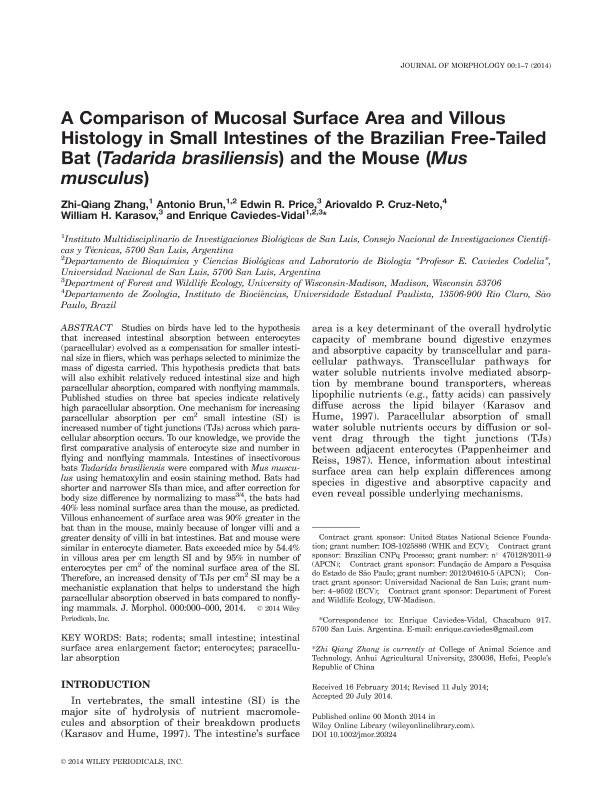Artículo
A comparison of mucosal surface area and villous histology in small intestines of the Brazilian free-tailed bat (Tadarida brasiliensis) and the mouse (Mus musculus)
Zhang, Zhi Qiang ; Brun, Antonio ; Price, Edwin R.; Cruz Neto, Ariovaldo P.; Karasov, William H.; Caviedes Vidal, Enrique Juan Raul
; Price, Edwin R.; Cruz Neto, Ariovaldo P.; Karasov, William H.; Caviedes Vidal, Enrique Juan Raul
 ; Price, Edwin R.; Cruz Neto, Ariovaldo P.; Karasov, William H.; Caviedes Vidal, Enrique Juan Raul
; Price, Edwin R.; Cruz Neto, Ariovaldo P.; Karasov, William H.; Caviedes Vidal, Enrique Juan Raul
Fecha de publicación:
01/2015
Editorial:
Wiley
Revista:
Journal of Morphology
ISSN:
0362-2525
Idioma:
Inglés
Tipo de recurso:
Artículo publicado
Clasificación temática:
Resumen
Studies on birds have led to the hypothesis that increased intestinal absorption between enterocytes (paracellular) evolved as a compensation for smaller intesti- nal size in fliers, which was perhaps selected to minimize the mass of digesta carried. This hypothesis predicts that bats will also exhibit relatively reduced intestinal size and high paracellular absorption, compared with nonflying mammals. Published studies on three bat species indicate relatively high paracellular absorption. One mechanism for increasing paracellular absorption per cm2 small intestine (SI) is increased number of tight junctions (TJs) across which para- cellular absorption occurs. To our knowledge, we provide the first comparative analysis of enterocyte size and number in flying and nonflying mammals. Intestines of insectivorous bats Tadarida brasiliensis were compared with Mus muscu- lus using hematoxylin and eosin staining method. Bats had shorter and narrower SIs than mice, and after correction for body size difference by normalizing to mass3/4, the bats had 40% less nominal surface area than the mouse, as predicted. Villous enhancement of surface area was 90% greater in the bat than in the mouse, mainly because of longer villi and a greater density of villi in bat intestines. Bat and mouse were similar in enterocyte diameter. Bats exceeded mice by 54.4% in villous area per cm length SI and by 95% in number of enterocytes per cm2 of the nominal surface area of the SI. Therefore, an increased density of TJs per cm2 SI may be a mechanistic explanation that helps to understand the high paracellular absorption observed in bats compared to nonfly- ing mammals.
Archivos asociados
Licencia
Identificadores
Colecciones
Articulos(IMIBIO-SL)
Articulos de INST. MULTIDICIPLINARIO DE INV. BIO. DE SAN LUIS
Articulos de INST. MULTIDICIPLINARIO DE INV. BIO. DE SAN LUIS
Citación
Zhang, Zhi Qiang ; Brun, Antonio; Price, Edwin R.; Cruz Neto, Ariovaldo P.; Karasov, William H.; et al.; A comparison of mucosal surface area and villous histology in small intestines of the Brazilian free-tailed bat (Tadarida brasiliensis) and the mouse (Mus musculus); Wiley; Journal of Morphology; 276; 1-2015; 102-108
Compartir
Altmétricas



